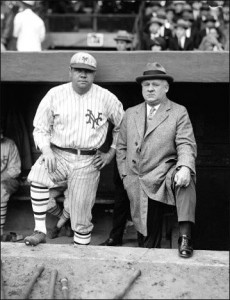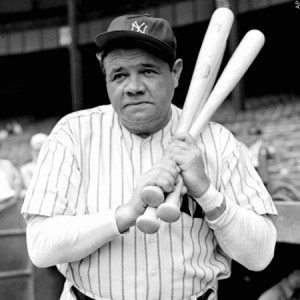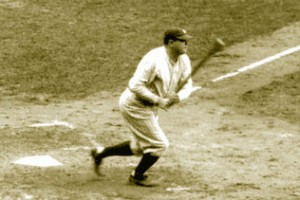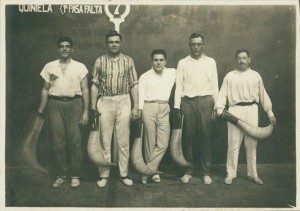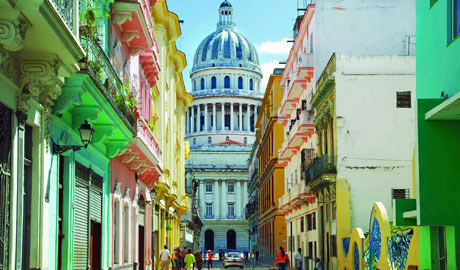SPORTS: WHEN BABE RUTH PLAYED IN CUBA.THE WHOLE STORY.
The fraternal relations held by John McGraw , the then manager of the New York Giants , who for several years was business partner of Racecourse Hipodromo Oriental Park, in the city of Marianao, and the Fronton Jai Alai, located in Concord and Lucena, opened the way to a surprise sporting event.
Babe Ruth , already famous for its 59 home runs during his first season in the majors, was in Cuba from October 30 until November 28, 1920 , the developer Cuban Abel Linares payed Ruth $ 20,000 , $ 2,000 per game , to join the New York Giants , Babe would play against the ‘Scorpions’ of Almendares and Team ‘Havana’ ..
The “Monarch “, and also she was known was 25 when he visited Cuba and was recently acquired by the Yankees , who had paid for Ruth to Boston a staggering $ 100,000 .
Arriving in Havana Babe Ruth occupy room 216 of the Hotel Plaza during their stay in the capital of Cuba , at this hotel is preserved as it was when it was occupied by the sensational Babe Ruth . It was then the U.S. a real highlight of baseball.
The Cuban entrepreneur Abel Linares intention to lift the sport in Cuba , brought to Havana , in October 1920 , the Giants , who joined Babe Ruth , to a series of twenty games. When he arrived in Cuba and the stops had started so it should participate in nine games. Of these, one was suspended . He then played in the Almendares Park, located in the area occupied by the bus station in Havana .
On Sunday October 10, 1920 arrived in Havana the Giants and on the payroll of 13 players appeared the following names: Frank Snyder and Earl Smith , receivers , George Kelly , first baseman , Larry Doyle , bartender , Dave Bancroft, shortstop , Frank Frisch , third baseman , George Burns , Vernon Spencer , and Ross Young, gardeners , Jess Barnes , Patrick Ryan and Paul Perrit , pitchers. ” Babe” Ruth , his wife and secretary John Igoe preferred arrived in Havana by sea to the port of Havana , from Key West, Oct. 29 .
A lot of onlookers welcomed and immediately the entourage boarded a car bound for the Hotel Plaza.
Visitors debuted on Saturday October 16 in the new Almendares Park in front of the club Almendares .
Babe Ruth , says the chronicler Elio Menendez retaking contemporary sources , disappointed the habaneros , but was placed on the fourth turn was given the defense to cover the center. Just managed to connect two home runs. Writers then explained that the pitchers , fearful of their power, working with bad balls , and he , hoping to please the public , threw them all .
The debut of the slugger American was quite productive , because in the first inning , with two runners on , took a strike straight and hit a very strong line that barely had time to react to the first baseman Felipe Hungo , knocking the mitt hand .
In his second appearance at the plate , this time in the third inning , the pitcher punished was the reliever Jose Acosta . On a curve that was a little high , the ” Babe” downloaded all the power of his wrists and the ball crashed into the fence in right for a distance of 385 feet .
Almost walking reached second base to notch a two base, but in the stands were murmurs of discontent because fans thought they had paid to see the first run of the best hitter in the majors.
There were games worse than others. As the fifth meeting , on 6 November. Christopher Torriente a black Cienfuegos , hit three jonrones in the game, and Babe could not hit unstoppable any Isidro Fabre , The Catalan . But in the end , Babe cashed the $ 2,000 agreed , and Torriente 200 pesos to his companions collected by passing the hat among the fans .
The next day the stage was set for the day Sunday . Now New York would by rivals to the Almendares . A team that would rank on the first pad the veteran big leaguer Armando Marsans , the same player who along with Rafael Almeida formed the duet of the first Cuban baseball Major League ( 1911 ) with the Cincinnati Reds .
Also the audience waited impatiently for the actions of Creole , Christopher Torriente , the burly mulatto in tournaments winter had gained fame for hitting long home runs and in the national media was known as “El Bambino Cubano” .
The Almendaristas commissioned the young Emilio Palmero responsibility for containing the mound for the Giants . In the first two turns, ” Babe” Ruth hit the same number of hits. At the top of the fifth chapter, with minimum margin of 2 x 1 to Americans , Palmero made history by becoming the first shooter Cuban capable of striking out Ruth .
According tell the writer Horacio Arugula, Emilio Palmero served three succulent rectazos the famed slugger and he merely listening to the tenor voice of the referee ” Kiko” Magriñat , who loudly defined : Good morning , good afternoon , good night . ”
‘s Own testimony newspaper recalls that on arrival “Babe” Ruth to the bank said surprised : Where did the Cubans the boy that? He assured them that can throw anywhere.
Babe Ruth traveled to Santiago de Cuba.
Enthused by the success of the games in Havana , Linares attracted businessman Santiago de Cuba Juan Lageyre who agreed to pay the ” Bambino ” no less than $ 3,000 to be presented in the best stadium in the city , Cuba Park, against a team Santiago , reinforced with players like Bartolo Portuondo and Valentin DREKE DREKE and Alejandro ” El Caballero” Oms with experience in the ball of the Negro Leagues and belonged to Cubans star of Linares and was led by the popular star Baseball Antillean then the eastern General Sagua .
The first game was a resounding victory for the Santiago 4-0 , but the news was that the victory achieved a pitcher named Paul Guillen , who never played in the champion and he had nothing on the ball , but that morning joy of more check, if possible, than Warren Spahn and do not raise the ball knees to any batsman , allowing himself the luxury of striking out Ruth in the second , although this will metio one tubey huge in the middle of the field in the 6to.el pitcher defeated was the big- leaguer Patrick Ryan .
In short , Frontline Cuban teams , ” The Monarch ” as they knew Ruth in Cuba , had the following numbers :
* On October 30, New York defeats Havana 4-3. Ruth hit a double and a triple in three shifts.
* October 31 : New York whitens 3-0 Almendares . Ruth hit 4-2 with a triple.
* November 3 : New York wins 7-1 at Havana and Ruth strikes out three times before shipments Cuban Jose Acosta ( ACOUSTICS ) .
* November 4 : New York defeat 10-0 to Almendares . Ruth hit 3-2 with a double.
* November 6 : The blue Cuban trounced 11-4 New York. Ruth fails to hit three times , but throws in relief . The hero of the game was the Cuban outfielder Cristóbal Torriente , who hit a double and …three homers !
The series would have more than 10 games started at its best, was a resounding success , but for the weather, they could not finish the last game due to continuous rains in Havana , or the 15 or November 16 could play and so they had to cancel. This did not stop Ruth to pay her what he owed. McGraw , manager of the team , take the opportunity to visit his friend and chess genius Jose Raul Capablanca. Moreover , given the success of the series.
But really the news that interested him Horace Arugula, Herald National were the side to the series: “Babe Ruth loses the money he had and 3000 that gave Santiago “: ” … the regulars Jai- Alai saw the Bambino squander money on gambling that began with relative success and concluded with none for the U.S. ”
In Santiago , the Bambino had lost everything in the game , in the game of dice at Casa Grande and , returning to Havana , according to the veteran chronicler , the Bambino arrived almost ‘ pulled ‘ with only 40 cents in his pockets.
On a night lost $ 800 in the Basque ball and , in another , because you juice Altamira against Eguiluz , $ 200 only in the pools , in another match Amaroto and Machi , left $ 700 for the house …
Ruth spent two more weeks in Havana to attend the horse races and continue to do the Jai – Alai and was remarkably cavalier with the country , its men and women , to respond in Santiago to questions Lageyre : ” This country is beatiful of people magnificent , sympathetic … and that gives an idea of why you went to a war of independence and women are the most elegant , surely, is in the world ” .
https://youtu.be/c1F2j9rz4r0
According to various chroniclers of the era as Horace Arugula and Vitico Munoz , reported earnings for the series were over $ 40,000 dollars , with which , according to Munoz , is could pay the payroll full of more than 6 teams in the majors then.
The success of the series, due solely to the presence of Babe Ruth to the New Yorkers.
But all I get in Cuba and more also , so lost in the fronton Jai – Alai and the racecourse . At Hotel Casa Granda in Santiago lost a fortune on the dice. But Babe was feeling happy and wanted to stay longer , an opinion which was not that of his wife and his manager .
Babe Ruth in 1921 would return to Cuba to enjoy the season hipica the racecourse Oriental Park, which became a dangerous hobby for the player who brought him financial difficulties in 1925.
Wiki/Various/Excerpts/InternetPhotos/youtube/thecubanhistory.com
The Cuban History, Hollywood.
Arnoldo Varona, Editor.
DEPORTES: CUANDO BABE RUTH JUGÓ BASEBALL EN CUBA. LA HISTORIA COMPLETA.
Las fraternales relaciones sostenida por John McGraw, por entonces manager de los Gigantes de Nueva York, quien durante varios años fuera socio en los negocios del Hipódromo Oriental Park, en la ciudad de Marianao, y del Frontón Jai Alai, situado en Concordia y Lucena, abrieron el camino al sorpresivo acontecimiento deportivo.
Babe Ruth, ya famoso por sus 59 jonrones durante su primera temporada en las Grandes Ligas, estuvo en Cuba desde el 30 de octubre hasta el 28 de noviembre de 1920, el promotor cubano Abel Linares le pago a Ruth $ 20,000, $ 2000 por juego, por unirse a los Gigantes de Nueva York , Babe jugaria contra los Alacranes de Almendares y al Equipo Habana..
El “ Monarca ”, como también se le conocía tenía 25 años cuando visitó Cuba y estaba recién adquirido por los Yankees, que habían pagado por Ruth a Boston la astronómica cifra de $100,000.
Al llegar a la Habana Babe Ruth ocupo la habitación 216 del Hotel Plaza durante su estancia en la capital de Cuba, de este establecimiento hotelero se conserva tal y como era cuando la ocupó el sensacional Babe Ruth. Era entonces el norteamericano una verdadera atracción del béisbol.
El empresario cubano Abel Linares con intención de levantar ese deporte en Cuba, trajo a La Habana, en octubre de 1920, a los Gigantes, a los que sumó a Babe Ruth, para una serie de veinte juegos. Cuando llegó a Cuba ya los topes habían comenzado por lo que debía participar en nueve encuentros. De ellos, uno se suspendió. Se jugaba entonces en el Almendares Park, situado en el área que ocupa la Terminal de Ómnibus de La Habana.
El domingo 10 de octubre de 1920 llegaron a La Habana los Gigantes y en la nómina de 13 jugadores aparecían los nombres siguientes: Frank Snyder y Earl Smith, receptores; George Kelly, inicialista; Larry Doyle, camarero; Dave Bancroft, torpedero; Frank Frisch, antesalista; George Burns, Vernon Spencer,y Ross Young, jardineros; Jess Barnes, Patrick Ryan y Paul Perrit, lanzadores. “Babe” Ruth, su esposa y el secretario John Igoe prefirieron llegaron a la Habana por la vía marítima al puerto habanero, procedentes de Cayo Hueso, el 29 de octubre.
Una gran cantidad de curiosos le dieron la bienvenida y de inmediato la comitiva abordó un vehículo con destino al hotel Plaza.
Los visitantes debutaron el sábado 16 de octubre en el nuevo Almendares Park frente al club Almendares.
Babe Ruth, dice el cronista Elio Menéndez retomando fuentes de la época, decepcionó a los habaneros, aunque fue colocado en el cuarto turno se le dio la defensa de cubrir el jardín central. Solo logró conectar dos jonrones. Cronistas de entonces explicaban que los pitchers, temerosos de su poder, lo trabajaban con bolas malas, y que él, con la ilusión de complacer al público, les tiraba a todas.
El debut del toletero norteamericano resultó bastante productivo, porque en la misma primera entrada, con dos corredores en circulación, aprovechó un buen lanzamiento recto y conectó una fortísima línea que apenas le dio tiempo a reaccionar al inicialista Felipe Hungo, sacándole el mascotín de la mano.
En la segunda comparecencia al plato, esta vez en el tercer episodio, el lanzador castigado fue el relevista José Acosta. Sobre una curva que quedó un poco alta, el “Babe” descargó toda la potencia de sus muñecas y la bola fue a estrellarse contra la cerca del bosque derecho hasta una distancia de 385 pies.
Casi caminando llegó a la segunda almohadilla para apuntarse un tubey, pero en las gradas hubo murmullos de inconformidad porque los fanáticos consideraban que habían pagado para ver el primer jonrón del mejor bateador de las Ligas Mayores.
Hubo juegos peores que otros. Como el quinto encuentro, el 6 de noviembre. Cristóbal Torriente, un negro cienfueguero, conectó tres jonrrones en el juego, y Babe no pudo batear imparable alguno a Isidro Fabré, El Catalán. Pero al final, Babe cobró los 2000 dólares convenidos, y Torriente los 200 pesos que sus compañeros le recolectaron pasando la gorra entre la fanaticada.
Al siguiente dia la escena estaba lista para la jornada dominical. Ahora los de New York tendrían por rivales a los del Almendares. Un equipo que alineará en la primera almohadilla al veterano big leaguer Armando Marsans, el mismo jugador que junto a Rafael Almeida formará el dueto de los primeros cubanos en el béisbol de las Grandes Ligas (1911) con los Rojos de Cincinnati.
También el público esperaba impaciente por la actuación del criollo, Cristóbal Torriente, el fornido mulato que en los torneos invernales había ganado fama por batear largos cuadrangulares y que en los medios nacionales era conocido como “El Bambino Cubano”.
Los almendaristas encargaron al joven Emilio Palmero la responsabilidad de contener desde el montículo a los Gigantes. En los dos primeros turnos, “Babe” Ruth pegó igual número de indiscutibles. En la parte alta del quinto capítulo, con margen mínimo de 2 x 1 a los estadounidenses, Palmero pasó a la historia al convertirse en el primer tirador cubano capaz de ponchar a Ruth.
Según contara el cronista Horacio Roqueta, Emilio Palmero le sirvió tres suculentos rectazos al afamado jonronero y éste se limitó a escuchar la voz de tenor del árbitro “Kiko” Magriñat, quien en alta voz definió: Buenos días, buenas tardes, buenas noches”.
El propio testimonio periodístico rememora que al llegar “Babe” Ruth al banco comentó sorprendido: ¿De dónde sacaron los cubanos al muchacho ese? Les aseguró que puede lanzar en cualquier parte.
Babe Ruth viaja a Santiago de Cuba.
Entusiasmado con el triunfo de los juegos en la Habana, Linares atrajo al empresario de Santiago de Cuba Juan Lageyre quien acordó pagarle al “Bambino” nada menos que $3,000 para que se presentará en el mejor estadio de la ciudad, Cuba Park, contra un equipo santiaguero, reforzado con jugadores como Bartolo Portuondo y Valentin Dreke Dreke y Alejandro “El Caballero” Oms con experiencia en la pelota de la Ligas Negras y que pertenecían al Cubans Star de Linares y estuvo capitaneado por la popular estrella del Baseball antillano entonces, el oriental General Sagua.
El primer juego fue un rotundo triunfo de los santiagueros 4-0; pero la noticia fue que la victoria la logró un pitcher nombrado Pablo Guillén, que nunca jugó en el champion y que no tenía nada en la bola; pero esa manana gozo de mas control, si cabe, que Warren Spahn y no le levantó la bola de las rodillas a ningun bateador; permitiéndose el lujo de ponchar a Ruth en el segundo, aunque este le metió un tubey enorme por el medio del terreno en el 6to.el pitcher derrotado fue el big-leaguer Patrick Ryan.
En resumen, Frente a los equipos cubanos, “El Monarca”, como conocían a Ruth en Cuba, tuvo los siguientes números:
* El 30 de octubre Nueva York derrota al Habana 4-3. Ruth batea un doble y un triple en tres turnos.
* 31 de octubre: Nueva York blanquea 3-0 al Almendares. Ruth batea de 4-2, con un triple.
* 3 de noviembre: Nueva York vence 7-1 al Habana y Ruth se poncha tres veces ante los envíos del cubano José Acosta (Acostica).
* 4 de noviembre: Nueva York derrota 10-0 al Almendares. Ruth batea de 3-2, con un doble.
* 6 de noviembre: Los azules cubanos vapulean 11-4 a Nueva York. Ruth no logra hit en tres oportunidades, pero lanza como relevo. El héroe del juego fue el jardinero cubano Cristóbal Torriente, quien pegó un doble y… ¡tres jonrones!
La serie que tendría más de 10 juegos comenzó de lo mejor, fue un éxito rotundo, pero por el clima, no pudieron terminar el último juego debido a las constantes lluvias en La Habana, ni el 15 ni el 16 de noviembre pudieron jugar, por lo que tuvieron que cancelarlo. Esto no impidió a Ruth que le pagasen lo que le debían. McGraw, el manager del equipo, aprovechó para visitar a su amigo y genio del ajedrez, José Raúl Capablanca. Además, dado el éxito de la serie.
Pero realmente las noticias que le interesaron a Horacio Roqueta, del Heraldo Nacional, fueron las colaterales a la serie: “Babe Ruth pierde el dinero que llevaba y los 3000 que le dieron en Santiago”: “…los asiduos al Jai-Alai vieron al Bambino derrochar el dinero en apuestas que comenzaron con éxito relativo y concluyeron sin ninguno para el americano”
En Santiago, el Bambino había perdido todo en los juegos, en el juego de dados en el hotel Casa Grande y, el regreso a La Habana, según el veterano cronista, el Bambino llegó prácticamente ‘arrancado’ con solo 40 centavos en los bolsillos.
En una noche perdió $800 en la pelota vasca y , en otra, porque le jugó a Altamira contra Eguiluz, $200 solo en la quiniela; en otro partido de Amaroto y Machi, dejó $700 para la casa…
Ruth estuvo dos semanas mas en La Habana para asistir a las carreras de caballos y continuar haciéndolo al Jai-Alai y fue extraordinariamente caballeroso con el país, sus hombres y sus mujeres, al responder en Santiago a preguntas de Lageyre: “Este pais es bellisimo, de gente magnífica, simpática… y eso da idea de porque ustedes fueron a una guerra de independencia y sus mujeres son de lo mas elegantes que, con seguridad, haya en el mundo”.
Según varios cronistas de la época como Horacio Roqueta y Vitico Muñoz, las utilidades reportadas por la serie fueron superiores a $40000 dolares, con los que, según Muñoz, se podían pagar las nóminas completas de mas de 6 equipos en las Mayores de entonces.
El éxito de la serie, debido exclusivamente a la presencia de Babe Ruth con los neoyorquinos.
Pero todo lo que gano en Cuba y mas también, lo perdió en el frontón Jai-Alai y en el hipódromo. En el Hotel Casagranda de Santiago perdió una fortuna en los dados. Pero Babe se sentía encantado y quiso quedarse mas tiempo, una opinion que no fue la de su esposa y su representante.
Babe Ruth en 1921 volvería a Cuba para disfrutar de la temporada hípica del hipódromo Oriental Park, lo que se convirtió en un peligroso hobby para el pelotero que le trajo dificultades financieras en 1925.
Wiki/Various/Excerpts/InternetPhotos/youtube/thecubanhistory.com
The Cuban History, Hollywood.
Arnoldo Varona, Editor.



 SPORTS: When BABE RUTH played in Cuba. The Whole Story. + DEPORTES: Cuando BABE RUTH jugó Baseball en Cuba. Toda la Historia.
SPORTS: When BABE RUTH played in Cuba. The Whole Story. + DEPORTES: Cuando BABE RUTH jugó Baseball en Cuba. Toda la Historia.